"Sculpture mode..." - Mr_Dham
Ha ha! Here, let me give you a hand (and a walnut):
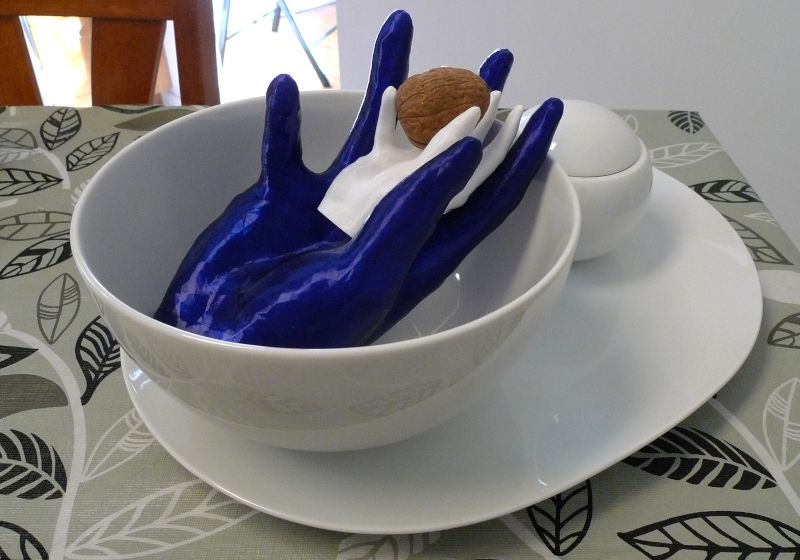
I/O Plate
Working on a more formal way to power and communicate with the kit. One owner (Rick Reid) had the neat idea to use keystone panel connectors, so I bought a bunch of different ones off Amazon and designed a 3D printed panel to accept them:
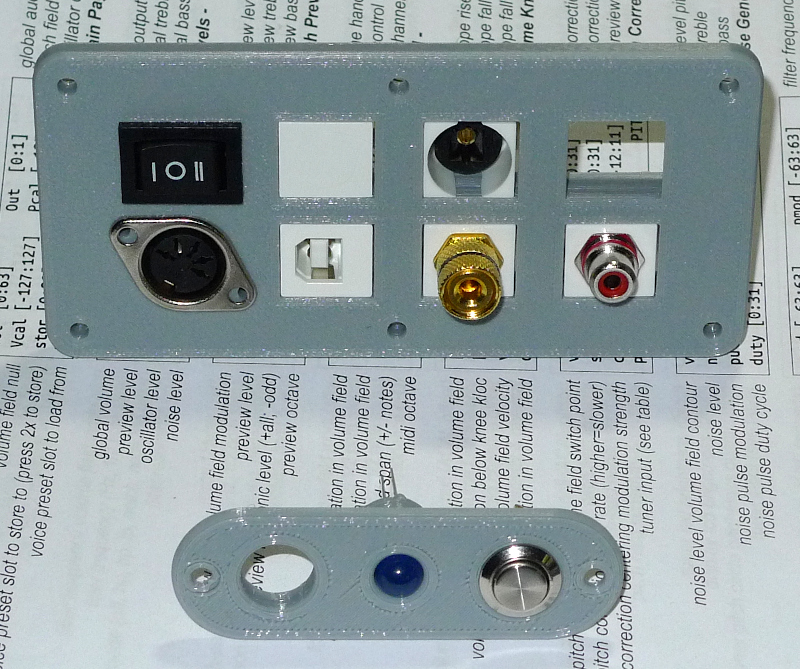
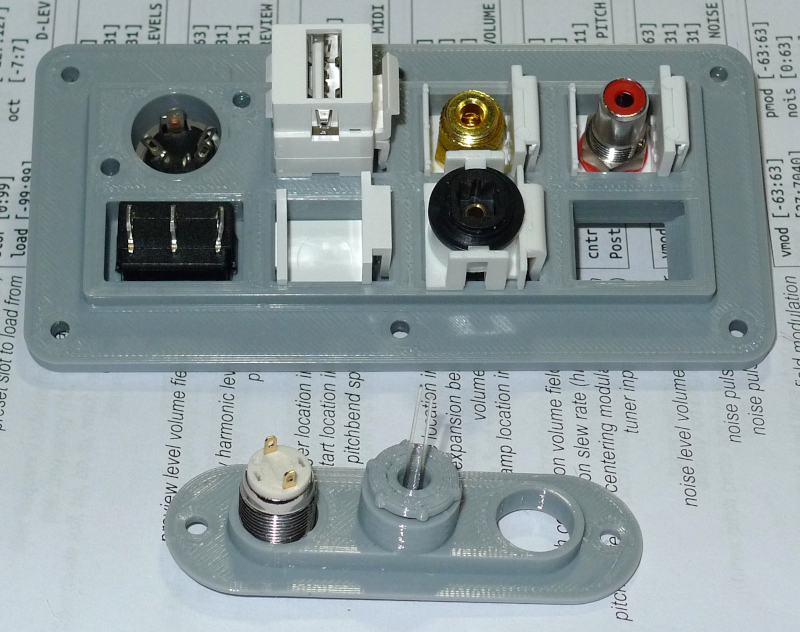
Using a SPDT toggle to select between a 5V barrel connector and the USB serial dongle. I bought some raw USB serial boards to see how they might work. I think the keystone panel is too small to accept 1/4" stereo headphone jacks, though keystone slots could be removed from the design to make way for one or two. I may remove the two center screw holes, the panel feels rigid enough to just use the corner holes. Got the 5 pin DIN socket screw locations a bit off, and that's fixed now.
On the bottom in each pic is a small ACAL / Mute / Mute LED panel. Of all the pushbuttons I tried these waterproof stainless ones work the best, and maybe ESD bleed could be incorporated into them. Have some 8mm red LEDs on order for the Mute LED. It's held in place by a hollow threaded bolt. The printing here isn't the best, these are just quick prototypes, and the camera flash is making them look a lot worse than they appear to the eye. Only one pushbutton is in place in the photo. I'm thinking of mounting it vertically, with the bottom button for Mute and the top for ACAL.
Also trying to figure out where the project is headed as a whole with no Waveshare FPGA boards to provide the beating heart.
Very good idea !
The fact that most of the people (like me) don't have skills or tools to properly drill square holes for USB, toslink or other PCB mount connectors will probably create a lot interrest for this solution.
I stuggled finding connectors that only require a round hole...
3D printer nicely avoids the problem of trying to put a square in a round hole.
Maybe a smaller plate for USB, toslink and power switch (all those square things) could be interesting. Leaving more degree of liberty for round things like jacks, RCA connectors, bananas, ...
"I stuggled finding connectors that only require a round hole..." - Mr_Dham
Me too. There is a round hole USB B connector on Adafruit (https://www.adafruit.com/product/4212):

And I bought some round hole rocker switches, but they seem less well-made than the rectangular variety.
"Maybe a smaller plate for USB, toslink and power switch (all those square things) could be interesting. Leaving more degree of liberty for round things like jacks, RCA connectors, bananas, ..."
Yes, though custom panels are pretty easy to generate too, and the keystone slots provide some future-proofing should one change their mind about I/O.
The I/O plate is 125mm x 60mm, which is the same width as the control panel and tuner. I think the main connectors would be:
1. Power rocker switch (also selects +5V source: USB or barrel connector).
2. MIDI TX 5-pin DIN.
3. 5.5mm dia. / 2.1mm dia. barrel connector (+5V).
4. Banana / wire binding post (ground).
5. USB B female connector (serial port & +5V).
#1 & #2 are too big for keystone inserts, so they are dedicated holes in the panel. #3 and/or #4 could be dedicated holes too, though #4 comes on a keystone insert, and I could drill a blank insert to hold #3. #5 is keystone only.
The remaining 3 positions could hold some combination of the following:
A. RCA jack for MONITOR SPDIF digital stereo audio (electrical TOSLINK, same as kit TOSLINK data).
B. RCA jack for LINE SPDIF digital stereo audio (electrical TOSLINK).
C. TOSLINK (fiber optic) MONITOR digital stereo audio.
D. 1/8" TRS headphone / line level MONITOR stereo out*.
E. 1/8" TRS headphone / line level LINE stereo out*.
F. RCA jack for MONITOR line level LEFT audio*.
G. RCA jack for MONITOR line level RIGHT audio*.
H. RCA jack for LINE line level LEFT audio*.
I. RCA jack for LINE line level RIGHT audio*.
J. Some DAC boxes have a TOSLINK out, which could provide TOSLINK LINE digital stereo audio*.
*(requires internal DAC box)
Options A, B, and D with an internal DAC box driven by TOSLINK for the headphone output might work. Or maybe D, F, and G with an internal DAC box driving all of them. Option C, D, and E would take two internal DAC boxes, though the LINE output one could be a less expensive variety.
I could also easily print some other variation here, like a 3 x 4 = 12 position panel to give 4 more keystone holes, or 3 x 3 = 9 to give one more in a square-ish panel, etc.
Lots of options...
Chicken Wire Antennas
Someone was wondering how something like a chicken wire antenna might work on the D-Lev, but I had no hard data. I've been meaning to test this like forever, so today was the day.
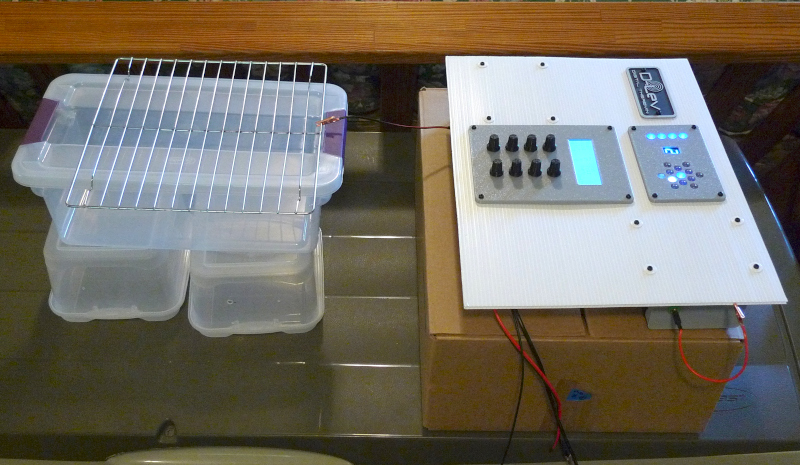
Above is my testing setup. A D-Lev kit sitting on it's shipping box and some plastic food storage containers supporting the antenna under test, everything on top of a huge plastic storage bin. I picked the volume axis for testing because it operates at a lower frequency and has a larger coil (2mH) than the pitch side. Using the librarian I peeked at the filtered volume number in memory and plugged this into a spreadsheet to calculate back to capacitance. Intrinsic C was then found by subtracting stray C from total C.

Above are the various antennas that were tested. I found two identical drying racks in our kitchen, covered both in aluminum foil, and removed the foil from one of them for testing by themselves. Also tested were some aluminum tape covered rods, the D-Lev kit plates, and some aluminum flashing antennas from the early days of prototyping. In particular, I was interested in the comparison between a sparse metal screen and plate of equal dimensions, so I took some 28 AWG (0.4mm dia.) bus wire and formed a 150mm square loop, which is the size of the D-Lev kit volume plate (green arrow above).
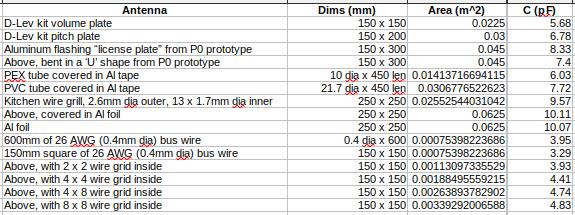
Above: results of the study
Observations:
1. From both the flashing and thin wire data, it seems that bending things lowers the intrinsic C. This can be a win-win if the final bent shape can more fully interact with the hand, because lowering intrinsic C and increasing mutual C increases the absolute sensitivity.
2. It's quite interesting that the wire grill has only slightly higher intrinsic C when covered in aluminum foil, or the the foil alone. The rods that make it up have significant surface area, but not that much. Being steel, they also have significant mass, making the grill much, much heavier than the foil (and mass works against portability).
3. The straight thin wire and thin wire loop had more C than I expected. I added internal grid sections in steps and measured each one. The capacitance of course increased, but with a diminishing returns trend:

Above: the resulting C vs. wire area as the internal 150mm x 15mm section is progressively filled with a grid.
4. I couldn't tell much difference playing the fine wire 8 x 8 grid as a volume antenna, but I think the true plate gave a bit larger playing field.
5. This experiment certainly doesn't rule out the use of a grid. One made of, say, thin aluminum tubing with sufficiently dense gridding should work almost as well as a plate of the same dimensions. Drilling or waffling a plate would work too. Though keep in mind that the player needs to be able to easily locate the plates out of the corners of their eyes to target them squarely, and it's nice if the audience can clearly see them too, so maybe try to avoid configurations that tend to blend into the background (suggestion: paint a bull's eye on it, or create some form of high contrast edge around it).
6. The advice I've been dispensing seems correct: highest sensitivity is associated with antenna area somewhere between 0.025m^2 and perhaps 0.05m^2, and with compact arrangements of that area (squarish plate) for maximal hand mutual C interaction.
7. Measured stray C at the start of the experiment was 6.93pF and 6.94pF at the end. The experiment took at least an hour to do, so this is really low drift over that interval - air core coils and DPLLs for the win!
Spreadsheet:
https://www.mediafire.com/file/zawnu5xlblfifoa/antenna_study_2022-06-05.ods/file
First Post Bookmarks Updated
I just went through this thread and brought the bookmarks on the first post up-to-date:
http://www.thereminworld.com/forums/T/28554?post=192741#192741
Enjoy!
(287 pages, 2866 posts, >10 years, >2 million views, EEK!)
Feeling Fluty
The flute voice really benefits from some velocity for staccato and puff. The pitch display and pitch correction help me play this with no real fingering technique, just flopping my hand around: https://d-lev.com/audio/2022-06-11_green_flute.mp3
Me playing Petra 'zo a nevez (What's New) with flute + Flamma reverb (had it in my head from xmas, took me forever to locate the title!): https://d-lev.com/audio/2022-06-11_petra_flute.mp3
Unified Field Theory
It's quite freeing to be able to easily shape, size, and locate the volume and pitch fields. Those who come from extensive analog Theremin backgrounds likely appreciate the ability to set up the D-Lev like their favorite analog instruments, but there's a light beyond these woods.
The sensitivities of the pitch and volume fields on an analog are just the opposite of what I find easiest to play. The volume field is too loose and the pitch field is too tight. My theory for fields in general is that they should be tight enough so that a minimum of hand/arm movement is required to play them, yet loose enough to be able to casually keep them stable. I mean, if your Theremin forces you to sit, or use some other form of body bracing like a sit/stand chair, or requires you to train at standing like a statue, something is fundamentally wrong. If your Theremin requires large quick movements of your volume hand to play certain phrasings, and even then maybe it can't do staccato, there's a problem with the instrument, not with you.
The volume field is the hardest to deal with in software but the easiest for the player to adapt to. Once the field is linearized, sized, located, and perhaps reversed (which may feel more natural to players who are new to the instrument) it must be expanded downwards through various means, and velocity added for staccato. The field can then be adjusted so that the player's hand is sufficiently distanced from the antenna (so as not to accidentally contact it during play) and the entirety of silence to moderate volume to full volume can be controlled easily and comfortably with the movement of the wrist only if desired.
The pitch field is the easiest to deal with in software but more difficult for the player to come to terms with. Once the field is linearized, sized, and located, it can be non-linearized near the antenna if desired for analog emulation, or for those with joint mobility issues, but that's pretty much it. The player must then devise a method which accommodates vibrato that isn't too deep or too fast, supports precision intervals, and hopefully doesn't lead in the long-term to injury. One can approach this problem intuitively or analytically, or a combination of both. One can also develop different methods and switch between them for the situation at hand. This is no easy nor quick task, but in the end I think it's much better to adapt the instrument to the player's style rather than the other way around.
Repairing the new Etherwave really drove this home to me. I found it almost impossible to hold a steady pitch (not a fault of the instrument per se, just the basic physics involved) and the volume field mushy and unresponsive (this could be addressed much better in the circuitry).
Eric:"...and the volume field mushy and unresponsive (this could be addressed much better in the circuitry)."
Yes. Dominik has solved it perfectly in his analog theremins. My own demonstrations of a circuitry that a change of hand velocity is using for acceleration-proportional attacks is similar. A new intuitive "theremin world" for volume control.
The First Law Of Theremindynamics: Conservation of Motion
"A new intuitive "theremin world" for volume control." - JPascal
Yes. A volume field with knee & velocity can be easily and fully controlled over a fairly small range of hand movement, which comports with my screed above. Theremins as a class are massively under-developed.
You must be logged in to post a reply. Please log in or register for a new account.